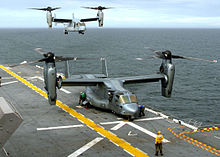Tilt rotor


With tilting rotor (also tilt rotor ) are propeller of actuators aircraft referred to in which the drive gondolas can be pivoted about the transverse axis to the direction of thrust to be changed.
They allow vertical take-offs and landings in a vertical position . For the transition to forward flight, the rotors are slowly swiveled horizontally and with increasing speed the lift is then generated by the wings - this is why one speaks of convertible aircraft . The transition from hovering to level flight is called transition in English.
A distinction is made between two variants:
- Tilt rotor, whereby the rotor blades can be adjusted cyclically (see swashplate ) and the lateral movement is controlled in hover flight . The design of the tiltrotors ( French convertible - German roughly "changeable") is said to be based on an invention developed in 1902 by the Franco-Swiss brothers Henri and Armand Dufaux , which they patented on February 24, 1904 and for the first time on April 14, 1905 performed publicly.
- Tilting propeller propellers , in which only the angle of attack (pitch eng.) Can be adjusted; In hovering flight, additional nozzles or propellers are used to maneuver; in the case of four-engine designs, the quadrocopter control may also be used.
Closely related to this design are the tilt-wing aircraft , in which, however, not only the engines, but also the wings are tilted, so that less air turbulence occurs.
Tilt rotor aircraft
As of 2012, only two-engine machines are in use or in flight tests, such as the V-22 Osprey and the AW609 . In the past, however, research has also been successful with four-engine models, for example the Bell X-22 .

